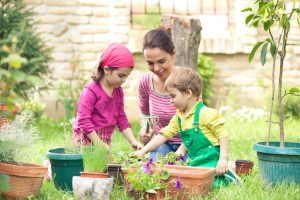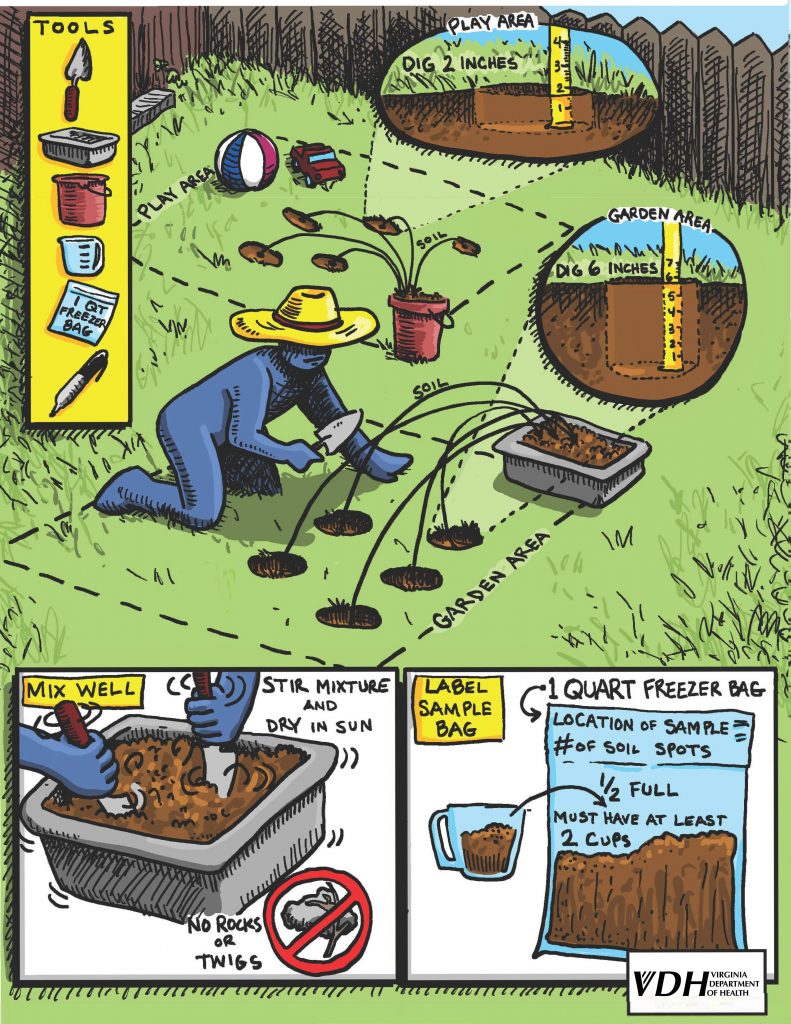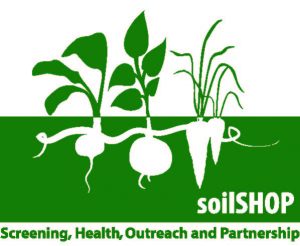Contaminants in soil
 Contaminants such as lead may be in your soil due to past property uses or may be naturally occurring. For example, lead that was used in gasoline and paint before 1978 may still be in the soil close to roadways or older houses. Lead is not absorbed by most plants, so the greatest source of exposure to lead is through eating contaminated soil or dust. Washing hands after gardening, and washing/peeling fruits and vegetables will prevent most lead exposure from home-grown produce. Learn more about lead in soil by watching this video created by ATSDR.
Contaminants such as lead may be in your soil due to past property uses or may be naturally occurring. For example, lead that was used in gasoline and paint before 1978 may still be in the soil close to roadways or older houses. Lead is not absorbed by most plants, so the greatest source of exposure to lead is through eating contaminated soil or dust. Washing hands after gardening, and washing/peeling fruits and vegetables will prevent most lead exposure from home-grown produce. Learn more about lead in soil by watching this video created by ATSDR.
Other contaminants such as pesticides and heavy metals other than lead may also be a concern, so practicing good hygiene is always a good idea, even if your soil tests low for lead.
How do I reduce my exposure to soil contaminants?
Steps to reduce potential exposure, especially if you have young children include:
- Minimize contact with bare soil by covering the soil with grass or adding clean soil or compost
- Practice good hygiene like using gardening gloves and washing hands after touching the soil
- Avoid tracking soil into your home by changing out of dirty clothes and shoes after you are finished gardening
- Wash your produce before eating it with water with a small amount of vinegar (1% solution) or soapy water
- Peel root vegetables and remove outer leaves of leafy vegetables (anything that comes in direct contact with soil)
- Plant gardens away from roads and houses or sheds that may have been painted with lead-based paints (before 1978)
- Use raised beds filled with clean soil
How can I have my soil screened for lead?
Attend a soilSHOP! The next soilSHOP will be at the Go Green Expo in Newport News on September 9th at Brittingham Mid-town Community Center, 570 McLawhorne Drive, Newport News, VA 23601. Make sure to bring a sample from your yard or garden and a fill-out the soil information form below. More information can be found in the soilSHOP videos below.
What is a soilSHOP?
Que es un soilSHOP?
Collecting a soil sample
Step 1: Identify an area of interest for your soil sample.
Step 2: Collect Soil – For a large area, collect soil from 5-10 random spots in that area, and combine in a clean container. For a small area, collect soil from 3 random spots and combine in a clean container.
Step 3: Mix soil well in clean container.
Step 4: Remove pebbles, rocks, and roots, and air dry. Do not use a flame, oven or hairdryer to dry the soil!
Step 5: Transfer 1 – 2 cups of the mixed soil into a clean one-quart zip-top bag.
Note: For more than one sample, repeat steps 1-5. Rinse your container between samples.
Limit of 3 sample bags/person.
Consejos para la toma de muestra
Paso 1: Identifique un área de interés para su muestra de suelo
Paso 2: Colecte el suelo – Para un área grande, colecte suelo de 5-10 lugares al azar dentro de su área de interés y combine en un recipiente limpio. Para un área pequeña, colecte suelo de 3 lugares al azar y combine en un recipiente limpio.
Paso 3. Mezcle el suelo en un recipiente limpio.
Paso 4: Mientras mezcla, remueva cualquier piedra, raíces u hojas que encuentre. Favor de no utilizar cualquier tip de llama, horno o secador de pelo para secar la tierra.
Paso 5: Transfiera 1-2 tazas del suelo mezclado a una bolsa limpia Ziplock de un cuarto de capacidad.
Nota: Si colecta más de una muestra, repita los pasos 1-5. Asegúrese de enjuagar el recipiente después de colectar cada muestra
Limite de 3 muestras/persona.
Learn how to collect a soil sample by watching this video created by ATSDR!

 |
 |
 |
